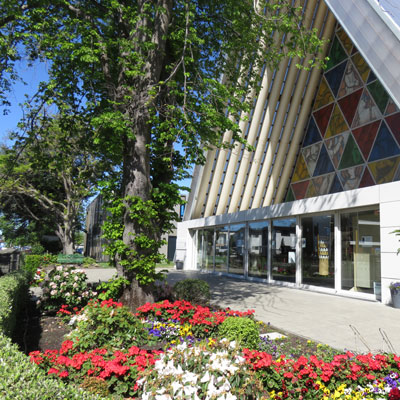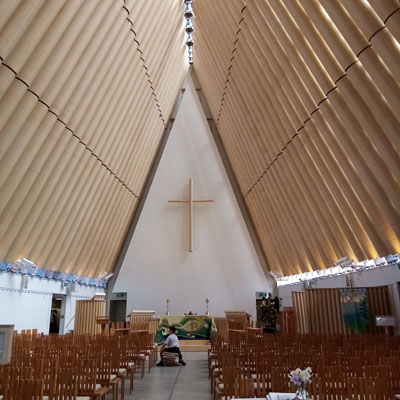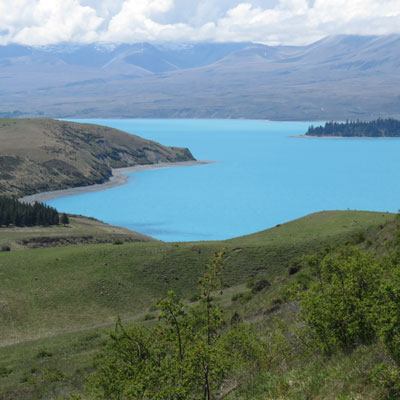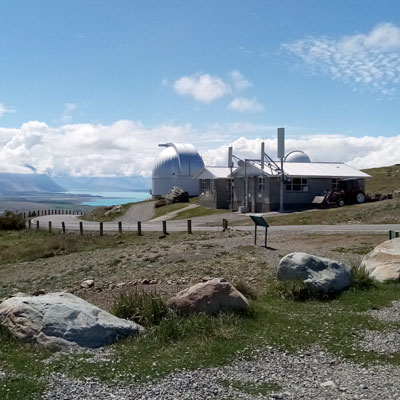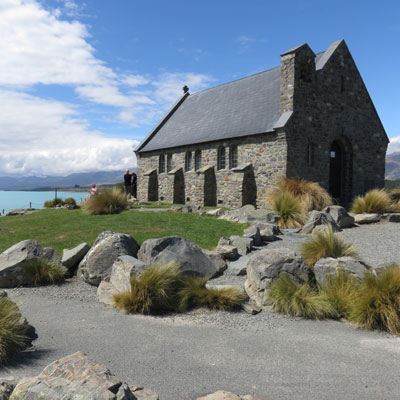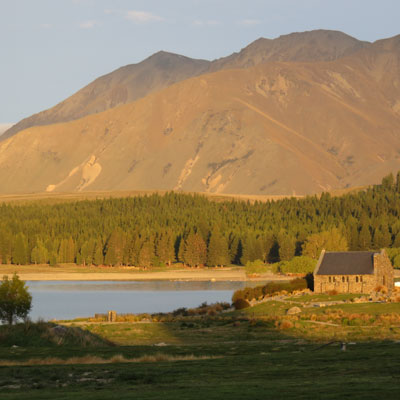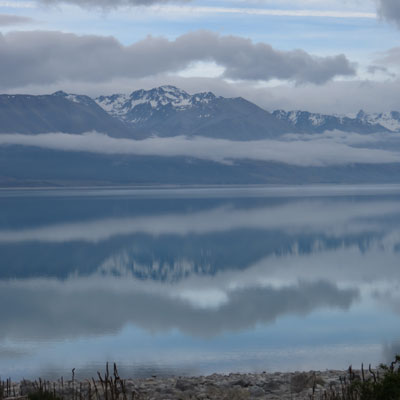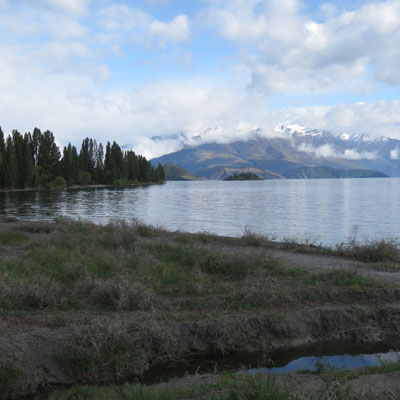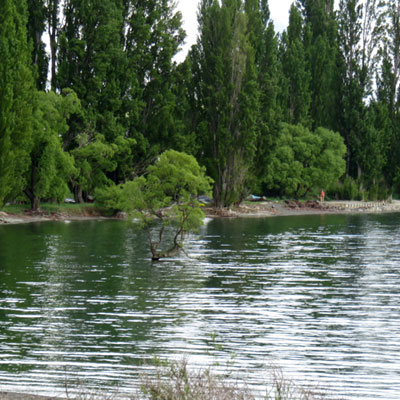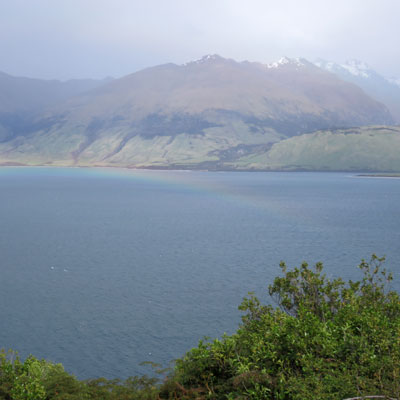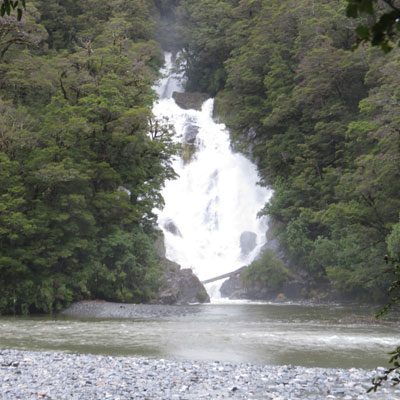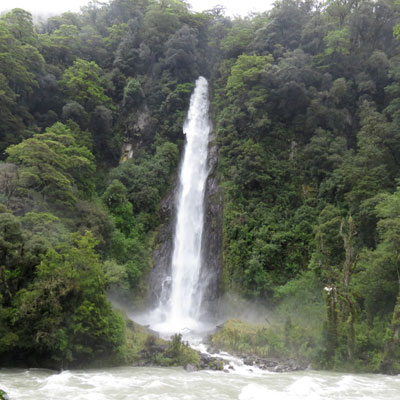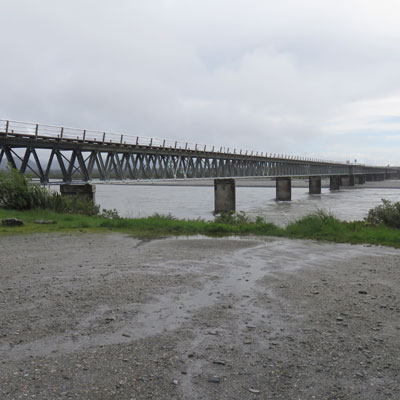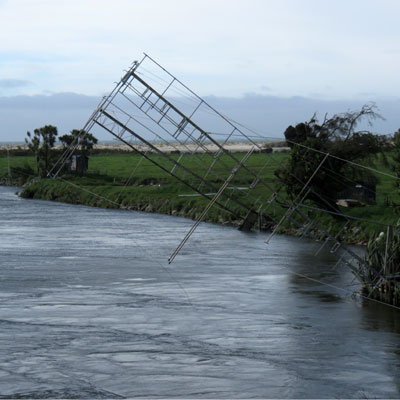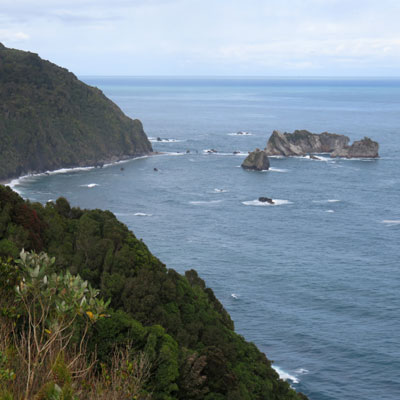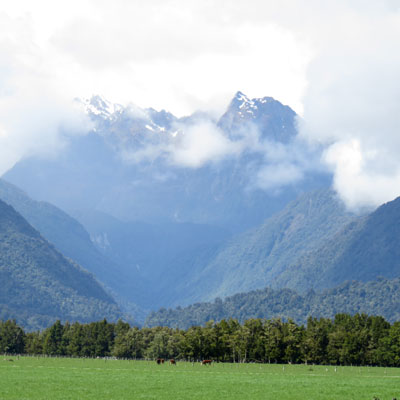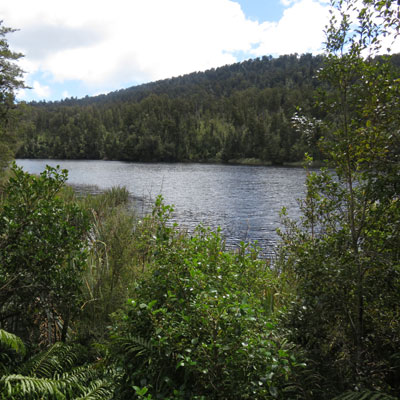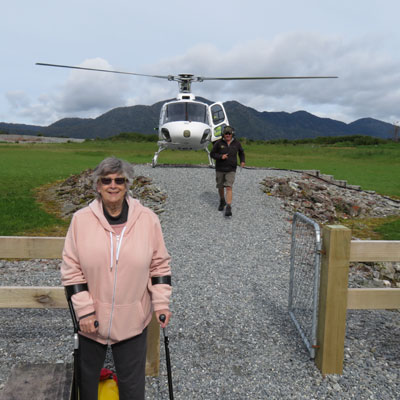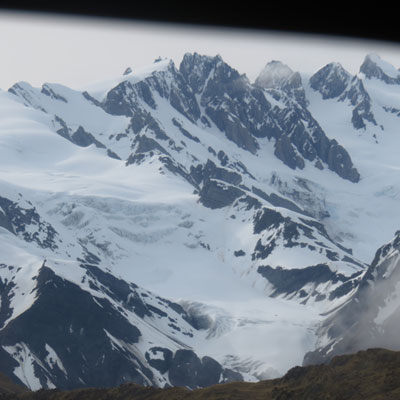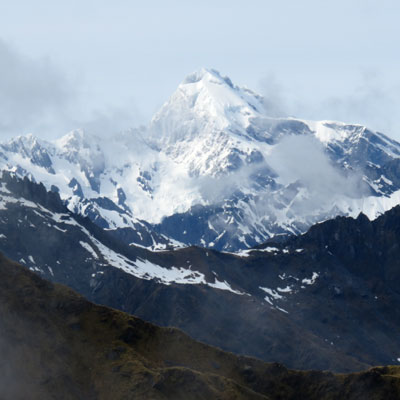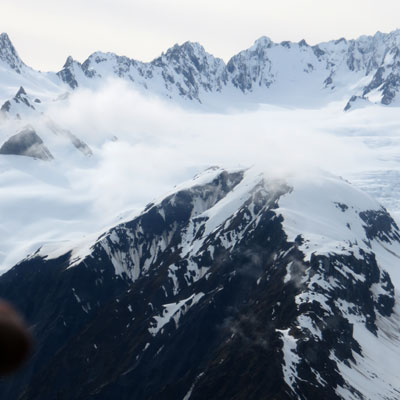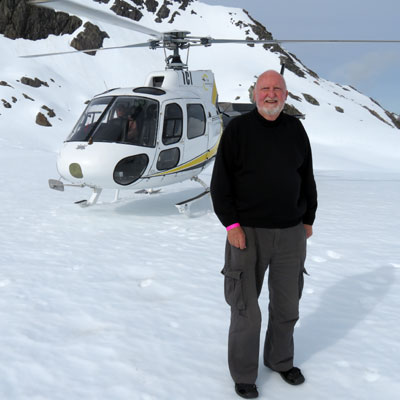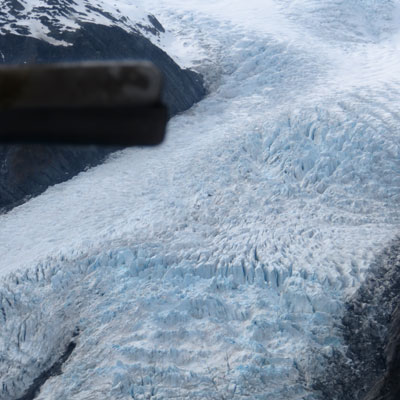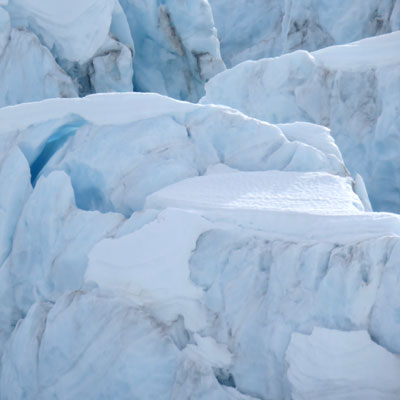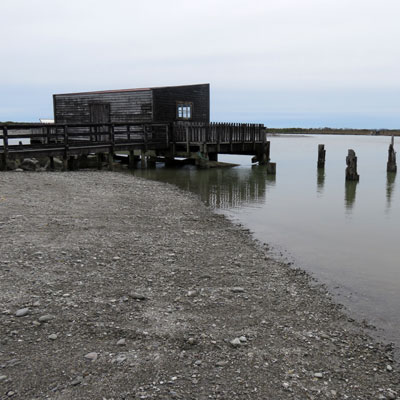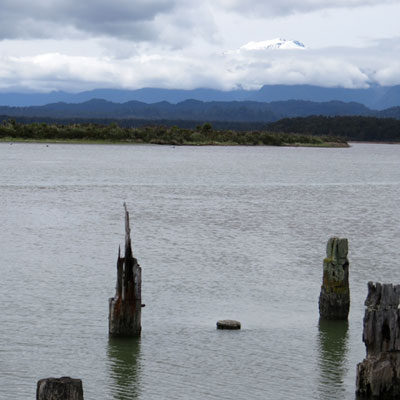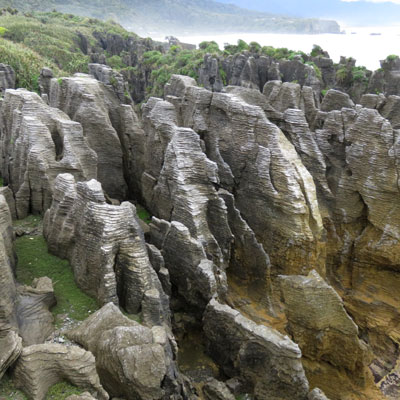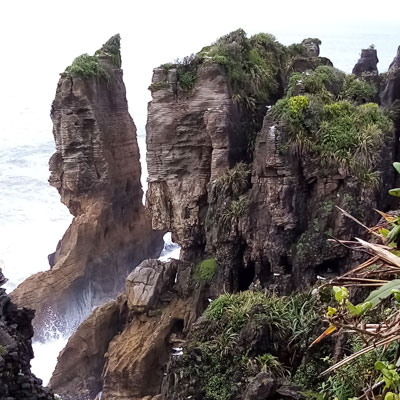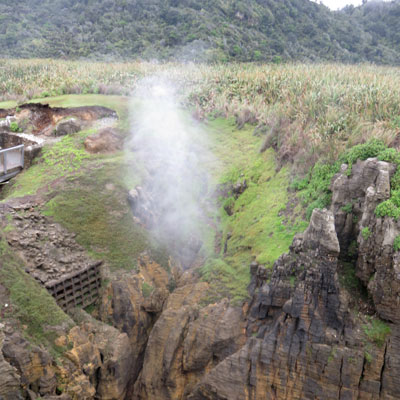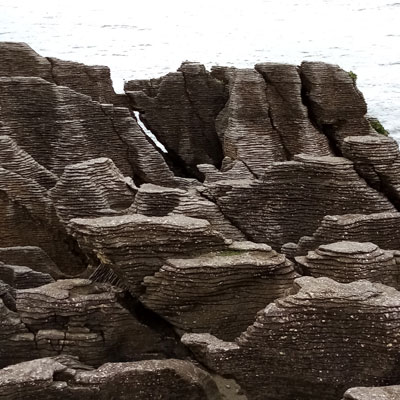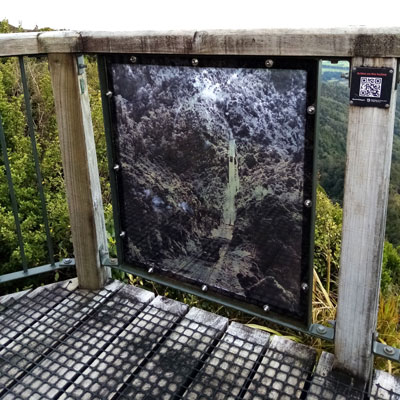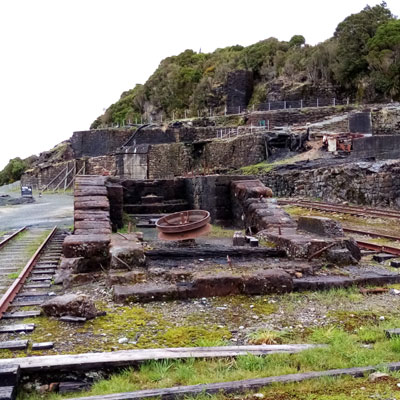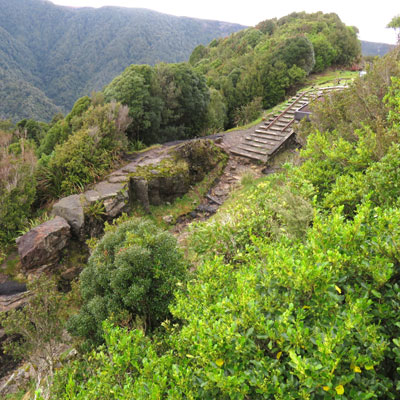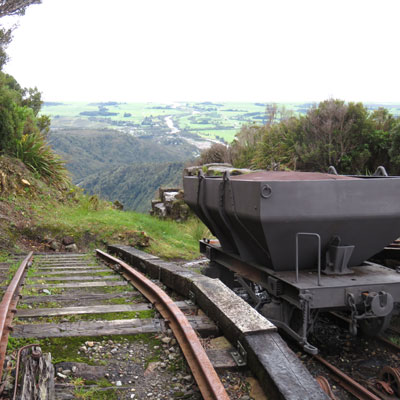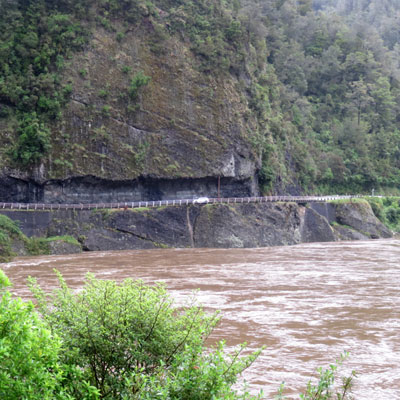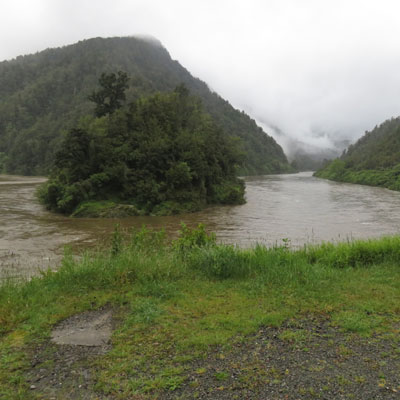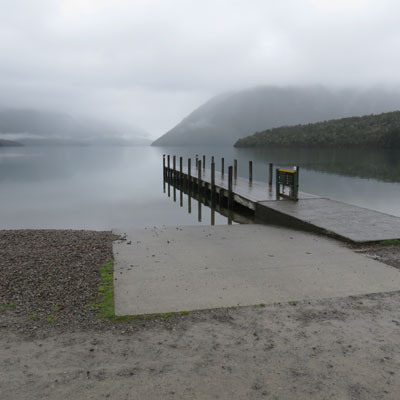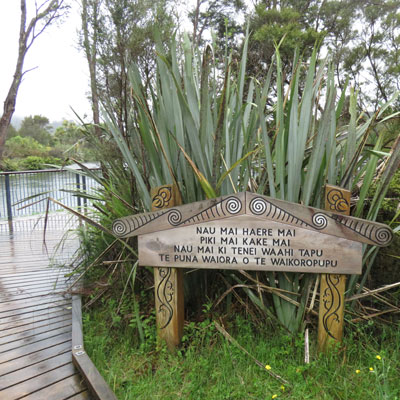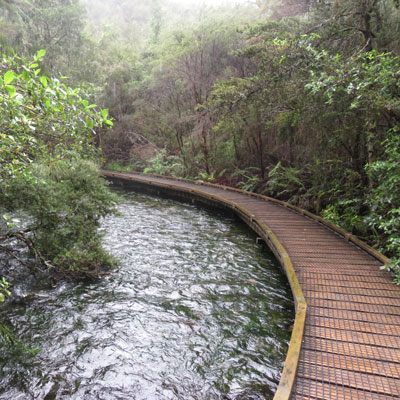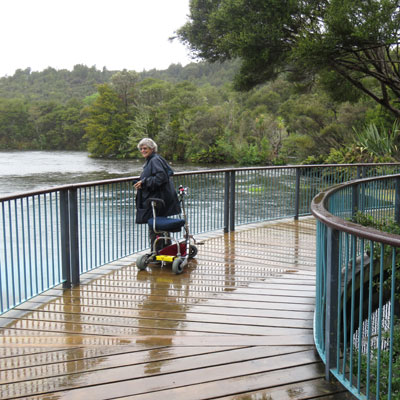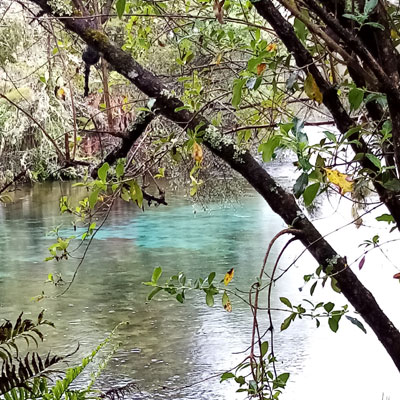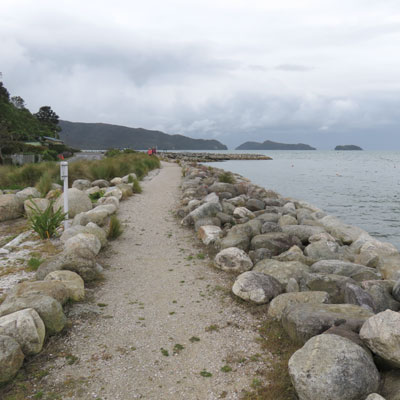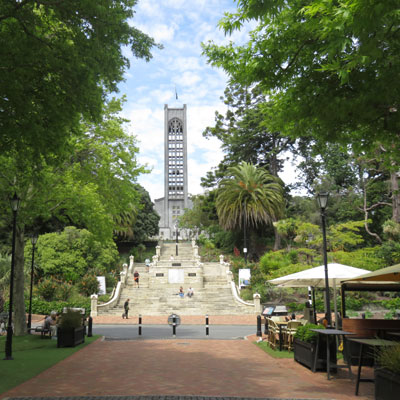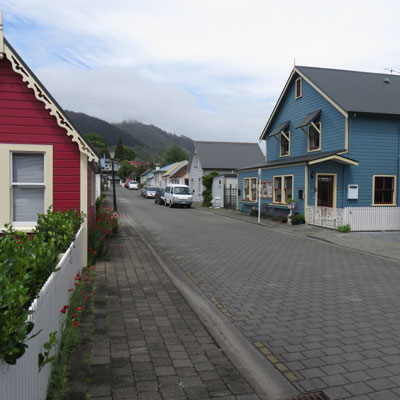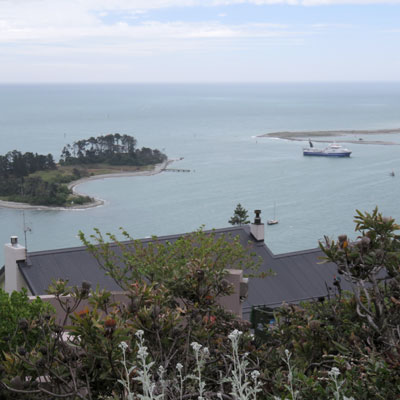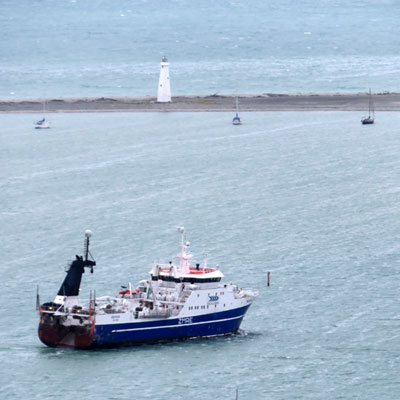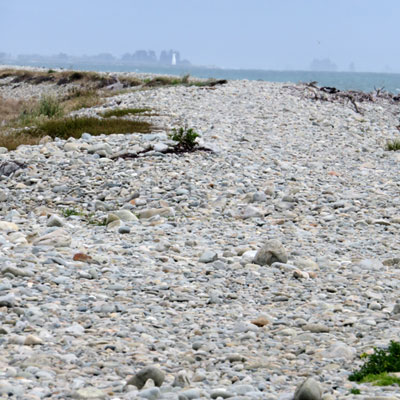A tour of the west coast of the South Island of New Zealand - driving from Christchurch to Nelson in October and November 2020
West coast of the South Island (download 148KB PDF file) | Map (or view in Google Maps)
West coast of the South Island 2020
Because we were suffering withdrawal symptoms from going so long without a change of scene, and wanting to help boost New Zealand’s economy after the ravages of Covid-19 had left so many fighting for survival, we decided to take a trip to parts of the South Island we had not yet explored.
Day 1.
We flew to Christchurch, where we had arranged for a hire car to use for the duration of the trip. Both Air New Zealand and Apex Car Rentals did their jobs admirably and we were in Christchurch city centre by lunch time.
This was our first visit to Christchurch since the earthquakes and we were anxious to see the changes that had been wrought, as well as the progress that has been made to rehabilitate the city. Although we had, of course, seen all the newsreel footage of the devastation, and followed the story of the extraordinary pace of much of the rebuild, we were still shocked at the sheer magnitude of the damage still awaiting repair and the vast tracts of land which most closely resembled bomb sites, even in the heart of the city. Facades of historical buildings shored up with piles of shipping containers were a sight for which we were unprepared and our hearts went out to those who called Christchurch home, and who must still be feeling the shock of the destruction, with these sights to remind them daily of their loss.
All was not so depressing, however, and the exuberant abundance of beautiful flower gardens everywhere, both in private houses and in public places, gave us heart and must surely have encouraged others too. One such colourful garden is in the grounds of the no less colourful Transitional Cathedral, also known as The Cardboard Cathedral, somewhere we had long wanted to see and which did not disappoint. As you may know, the cathedral, a basic A-frame structure, was built as quickly as humanly possible after the quake, in order to give the Anglican community a home and somewhere to worship after the immense shock of the destruction of the iconic Christ Church Cathedral.
There is considerable controversy surrounding the rebuilding of the original cathedral, and the very stark modernity of the Cardboard Cathedral is not universally popular, but this is not the place to enter the debate about either. I will say, however, that it is incomprehensible to me that anyone could fail to be filled with the Spirit when inside this extraordinary space. The photos show you the beauty of the design but only being there gives one the feeling of tranquility and of being in a special place; not even the group of boisterous choir boys, early for practice, who had been charged with placing cushions on the chairs but chose instead to build forts out of them could mar the peace!
Day 2.
We set off early towards Lake Tekapo, driving via the Rakaia Bridge and Ashburton to our first stop, Geraldine. Here we had breakfast at the café in the famous Barkers of Geraldine building and sampled some of their excellent preserves, pickles and other foodie delights. For the first, but not the last time, we had to remind ourselves that we had a limited weight limit for our baggage and therefore could not fill the car with samples of everything delicious.
From Geraldine we carried on through Fairlie and Burkes Pass, and enjoyed the magnificent scenery of the Mackenzie Basin. We arrived at the Lake Tekapo YHA, where we had booked a bed for the night, and were delighted to see it was right on the shores of the lake. We had high hopes of some star-gazing that night, this being a designated ‘Dark Skies’ area with no light pollution. The weather was glorious and we decided to make the most of it as we headed off up to the mountain-top Mount John Observatory. Spectacular views all around meant the camera never stopped clicking, but the most breathtaking sight of all was the extraordinarily bright turquoise hue of the water of the lake; quite dazzling. Sadly, one has to actually see it with the naked eye as the camera just doesn’t do it justice – a lovely shade of blue though it looks in the photos.
We went back down the mountain to explore the lake front and admire the pretty little Church of the Good Shepherd, reputedly the most photographed in New Zealand. We also went to find an early dinner (it was a long time since Geraldine!) so that we would be finished in time to watch the sunset and, hopefully, catch the stellar extravaganza for which the place is famous: it is a World Heritage Dark Skies site. Sadly, the clouds began to gather and the stars did not appear, but we were treated to a splendid sunset and the church looked particularly beautiful captured in the golden glow. We are so blessed with wonderful night skies and lack of light pollution up here at home that we could not be too disappointed at the lack of stars, but did feel sorry for other visitors for whom this was to have been a highlight of their holiday. We just told them to head North!
Day 3.
Today’s destination was Wanaka, on the shores of another stunning lake. On the way there we went to Lake Pukaki where there are magnificent views of Aoraki-Mount Cook, New Zealand’s tallest mountain. Sadly low cloud shrouded the mountain ranges and we were not lucky enough to catch more than a glimpse. There would be other opportunities in the coming week so we tried not to be too disappointed and continued with the drive, passing through Twizel and then over the Lindis Pass – one of the highest main roads in the country, with really quite majestic views in every direction. Unfortunately conditions were not suitable for stopping to take photographs, but we will not soon forget the scenery we saw. We later crossed the mighty Clutha River, the second longest in New Zealand and the longest on the South Island, driving over the famous Red Bridge, and were surprised at the volume of water, given that there was talk of water shortages and dried up rivers.
We arrived in Wanaka in the early afternoon and took advantage of the fine weather to explore the town and then drove around as much of the lake shore as we could. Again, mountain tops were obscured by cloud but still the views were very attractive and the spring-green of the leaves a refreshing sight. We paid a visit to the Lake Wanaka Tree (supposedly the most photographed tree in New Zealand!), which stands alone some distance from the lakeshore and looks very pretty reflected in thecalm waters… though I can’t say we were over-awed by it; maybe it is better arrayed on a blue-sky day in autumn, with its golden foliage adding colour and with the snowy mountains in the background. Certainly most of the photos we have seen were have been taken in such conditions.
Day 4.
Halloween today and we were feeling a little sad that we would miss the usual parade of wee Trick or Treaters who normally visit our home. No doubt plenty of neighbours made up for the dearth of lollies at Number 38. I do hope so.
We drove from Wanaka to Haast, via Lake Hawea, which is separated from Lake Wanaka by a narrow neck of land. As we looked back for our final glimpse of Lake Wanaka, we were astonished to see a rainbow over the lake – not just any old rainbow arcing through the sky, but one which was lying flat on the surface – a complete arc, just horizontal!
We drove to Haast and made for the many and various lookout spots where views of Mount Aspiring were promised. Our aspirations to see this were confounded due to torrential rain which dogged us throughout the day. When it wasn’t raining so hard the windscreen wipers could hardly cope, we found ourselves driving through fog or cloud, barely able to see the bush either side of the road. We passed several paths to spectacular waterfalls and one can only imagine how impressive they would have been with the volume of water filling them.
Sadly, however, the tracks were too waterlogged to allow even the most nimble footed to negotiate, never mind me with my wheelie-walker (and even Martin is less keen on slippery or rough terrain underfoot these days). There were one or two falls that fell right by the road, Diana and Orman; these were beautiful, but could only be glimpsed through the rain and fog. Fantail, although a trek away from the road, did come into view at a distance for a moment or two as the clouds parted, and provided a wonderful sight.
Low cloud (fog) and rain hid Haast but by late afternoon it had eased off and we were able to enjoy a drive along the water’s edge and see the raised jetties of local residents, whitebaiters and boaties. Presumably they were a security device so no-one could access their properties while they were away? We were interested to see the many varieties of reed and grasses as well as marsh plants along the water’s edge of the estuary. We saw ferns of all sizes, from the length of a joint on my little finger to 2 or 3 metre high tree ferns known here as Pongas (the iconic New Zealand Silver Fern), which abounded. In addition, low-growing but very densely packed native bush lined both sides of the road, the canopies resembling nothing so much as giant broccoli.
We took the opportunity to drive over the Haast River Bridge, at 750m it is the longest single lane bridge in New Zealand. Single lane bridges are shorter but more plentiful up here in the north and a source of frustration in the summer when townie visitors don’t understand the rules and cause traffic jams. We wondered how they would manage with one so long but discovered that there are actually two passing places so we then wondered if it really qualified for the ‘single lane’ distinction!
A large group of would-be whitebaiters filled our hotel but although friendly and jolly, they were very frustrated by the first day of their annual jamboree being rained off – wimps? Or do whitebait hide from the rain … perhaps they don’t like being wet?
Day 5.
Franz Joseph Glacier was our destination but our way took us via Ship Creek and Lake Paringa. We stopped for breakfast at a salmon hatchery, where Martin indulged in a home bred, home smoked salmon and cream cheese bagel. We watched the salmon of various sizes swimming in the honeycomb arrangement of tanks, and observed the resident ducks enjoying a dip in the same tanks.
The weather was poor again so we didn’t explore as far as we might have done, but it cleared up towards lunchtime and we headed out to Lake Matheson, where there is a good restaurant/cafe and, just a couple of kms away, a splendid viewpoint with wonderful views of Aoraki- Mount Cook and Fox Glacier. We were booked for a helicopter trip the next day but as the weather forecast was so dire, we dropped in to the offices to see if it was likely to be flying. We were told they’d been grounded for some days but that hopes were high for our 9am departure. The afternoon brightened a bit so we crossed our fingers and kept them that way.
This was the day we celebrated our 51st wedding anniversary and did so in fine style with an excellent dinner at Alice May’s Restaurant, conveniently situated in our hotel. An ancestor of the current owner, Alice May Parkinson shot her faithless lover … You can read the whole story of this feisty woman and her fight for justice on the Alice May website.
Day 6.
We awoke to sunshine and blue skies, which boded well for our helicopter flight. Our flight took off as scheduled and with us were three other people, who had been on standby for some days. Our pilot was easy company and all 6 of us on board gelled well – just as well in such close quarters. We had nearly 40 minutes of spectacularly breathtaking views of Aoraki-Mount Cook, Mount Tasman and both the Fox and Franz Josef glaciers, to say nothing of the surrounding countryside.
A 15 minute landing and walkabout on the snowfield that forms the shoulder between the two mountains was a bonus, as we hadn’t paid the extra $45 each for a landing but the others had, so we were asked if we would mind the longer trip. Of course we didn’t! The time flashed by, as we peered down into fissures in the glaciers, discovered the many different shades of blue and white and generally enjoyed the eagle’s-eye view of these rivers of ice, only properly appreciated from above.
Apart from blue and white, there were occasional smears of grey which the pilot explained was ash from the Australian bushfires which had been raging for so long. We were seeing the mountain tops and glaciers after some fresh snowfall but until that happened, the whole area was dirty grey, with the white almost completely obscured. He fears that summer visitors will not have the beautiful clean views of snow and ice that we were enjoying, as the fresh fall of top snow will have melted and left the ashy mess which was lying under it. He thinks that in decades and centuries to come, geologists will come across this layer and be able to pinpoint it as 2020, year of the worst fires Australia has known.
In the afternoon we went to look at Franz Josef Glacier from ground level, which was very interesting but we were glad we had also seen it up close, as the texture of the ice is less pronounced at a distance. The weather closed in a little during the afternoon and the mountain tops became obscured by cloud once more, so we were very glad we had booked the early morning flight.
We also went to see what we could see at the old mining community of Okarito Lagoon but apart from one or two original buildings from when the first settlers arrived, it was pretty desolate; what difference the weather makes!
A magnificent sunset rounded off a good day and we celebrated it with another excellent dinner at Alice May’s.
Day 7.
We headed north up the west coast and had a breakfast stop at Hokitika which will be familiar to those who have read Eleanor Catton’s prize-winning novel ‘The Luminaries’ about the gold rush days when the town was in its heyday. The weather had deteriorated overnight so the drive was a soggy one, affording us no views and, even though we parked opposite the café, we got drenched just crossing the road. We noticed some art deco style buildings and admired them but photography was out of the question, unless we wanted pictures of stair-rods of rain, and drowned cameras. We carried on with the journey north but the atrocious weather meant a stop at Greymouth was an unattractive proposition and so we kept going, after driving around and seeing the little that could be seen.
As we arrived at what was to be one of the highlights of the trip, the weather suddenly cleared and we were able to enjoy our visit to Punakaiki Pancake Rocks, a spectacular illustration of the powers and wonder of nature. They defy description other than piled up pancakes! One pillar would have made an splendidHalloween figure a few days earlier! An excellent website which explains how these extraordinary rock formations come about can be found at the Punakaiki website where there is also information about some of the other natural attractions of the West Coast.
We arrived at our destination of Omau, not far from Westport, and situated on Cape Foulwind. Here there is a beach used extensively by fur seals as a base and also a breeding nursery. We were told that there would be young on the beach, even if their parents were out foraging the ocean for a seafood supper but, sadly, there were none; no doubt they were sheltering from the driving rain.
Also near Westport is the old coal mining centre, Denniston Mine. A friend had recommended it as a place to visit and also put me on to a couple of books by Jenny Pattrick: ‘The Denniston Rose’ and its sequel, ‘Heart of Coal’. We decided that sitting around a motel room on a wet afternoon was a waste of time, so headed up the mountain to the disused mine, in the hopes of seeing something of the old Incline ‘railway’ and other machinery. Once again, the rain stopped and the sun appeared just as we reached the mine and we had a fascinating half an hour exploring this well-presented example of our industrial history – not all tidied up and titivated but left almost as one imagines the last miner would have seen it as he went off shift, many decades ago.
Excellent story boards were informative and also entertaining, with cartoon-style depictions of the various workers and their tasks – not at all funny and extremely dangerous they were, too. Old photographs were also printed on the glass panes of the shelters where many of these explanatory boards were housed, and at times I could almost feel Rose’s presence and could certainly envisage parts of the stories in the books. The books are works of fiction but are influenced by the true history of the mine and an appendix giving the timeline of the history of the mine from inauguration of the Incline in 1879 until the Incline closed in 1967 helped us put into context, from an engineering point of view, what we were seeing.
A bonus to our trip up the mountain, and something which few guidebooks mention, was the huge panoramic vistas up and down the West Coast, as far as the eye could see. As we descended the mountain, the weather closed in again but our motel was right next to a pub selling delicious meals and so we didn’t get too wet when the time came to venture out for dinner.
Day 8.
This was a long day’s drive to Nelson, again in appalling weather, which meant we did not make as many stops as we had planned. We did try to visit the historic goldmining town of Westport, also known for its art deco buildings, but unfortunately it did not look invitingand we did not linger.
We were not able to visit the famous swing bridge (the longest in new Zealand) as it is now within an Adventure Park for which the admission fee was too high for just the quick look we wanted – it was too wet to even contemplate crossing it, even if we had been nimble enough to try. We then continued along the banks of the river and through the Buller Gorge. The engineering required to make the road (and many others we had travelled on this trip) was something to be marveled at, particularly where they had scooped a half-tunnel out of the sheer rock face, just high enough to accommodate cars and camper – presumably lorries too as there were no other through roads, but they would have had a tight squeeze.
We followed the road to Murchison, which has the looks of a frontier town with many old wooden buildings still in use as shops. This is where we stopped for a lunch of pasties as big as our plates; we should have had one to share!
Our next stop was at Lake Rotoiti, which was stunningly beautiful in spite of the rain and cloud. So many shades of grey and silver lent it an ethereal air and we had it to ourselves – apart from some disconsolate ducks who looked about as fed up with the weather as we were by now! We carried on to the township of St Arnaud, which looked prosperous but almost deserted, the smart modern houses almost entirely being holiday homes, much used in the skiing season.
We eventually arrived safely at our city centre hotel in Nelson and opted for dinner in their highly-recommended restaurant; an excellent choice it turned out to be, too.
Day 9.
We set out to explore Golden Bay and Abel Tasman National Park and hoped that we might be able to get within sight of Farewell Spit. We scheduled a breakfast stop in Motueka and found an extraordinary barn of a place, right in the main street, called, I think, The Wholefood Café, which we feared might mean ‘orribly ‘ealthy fare but which actually had a menu of delicious and unusual meals and a cold cabinet full of the most decadent and desirable cakes and other goodies. The coffee was, unusually, from Timor l’Este and was also excellent.
The weather (again!) was against us and the long drive to Golden Bay proved to be something of an endurance test, particularly as there were road works with delays of up to 15 minutes each way. These were on a stretch of road scaling Takaka Hill, which is actually a high a mountain in anyone else’s book – they have a mastery of understatement in these parts – and which we had been warned was a nerve wracking drive as the road clings to the edge of the contours and looking down is a recipe for vertigo. This wasn’t a problem for us, however, as the valleys were full of cloud, rising above us as well as below and so we were driving through them most of the time.
Coming back down later in the day, however, gave us the full stomach-churning roller-coaster ride as we could see just how far up we were and just how close to the edge; very ‘exciting’! Needless to say, we didn’t make it to Farewell Spit and actually achieved very little. A sighting of Split Apple Rock between Kaiteriteri and Marahau in the Abel Tasman National Park was denied us as the only access was along a rugged path which was unsuitable for wheels and too far for crutches. Martin would have gone for a look but there was nowhere to park anywhere near and it was, you’ve guessed it, raining hard. Never mind – maybe we will go back one day and be luckier with the weather.
The crystal clear Waikoropupu Springs were a must-see, regardless of the weather and even though the dimpling raindrops meant we didn’t have quite the looking-through-glass experience one would expect on a clear day, they were still quite beautiful with wonderful colours shining through providing a breathtaking spectacle. The path wound through the forest which was full of many varieties of ferns and other flora, including a lone wild strawberry, and even the dull weather couldn’t spoil the vivid spring green of the new growth and unfurling fern leaves. The fast-flowing river offered a musical soundtrack and the visit was an altogether very uplifting experience.
We enjoyed the day out and arriving back in Nelson earlier than anticipated, we had time to explore the town. The rain had stopped and we had a good look round, particularly at restaurants where we might have dinner. We found a wonderfully authentic Italian place called Lombardi’s where the owner was larger than life, the archetypical Italian flirt and joker; that might have been trying but he kept it just on the right side of amusing at the same time as keeping an eagle-eye on every table.
We couldn’t resist booking a table and were not disappointed. Excellent food and wine and lots of fun made the day a memorable one.
Day 10.
This morning we had an appointment to meet up with one of the extraordinarily talented and knowledgeable staff of Nelson Provincial Museum. The museum has many similarities to Museum @ Te Ahu, of which I am a Trustee, and I was keen to chat to them to share experiences and pick their brains as they have experience of a new system we are currently adopting. Nils Pokel was endlessly patient and very helpful, interesting and informative – he also bought us some very good coffee at the café attached to the museum. After taking up far too much of his time, we enjoyed a good look round the museum’s permanent exhibition, which was extremely interesting and gave a terrific insight into the lives of the Maori from that part of the country as well as of later settlers from across the world.
Nelson is one of the oldest towns in New Zealand and many of the original buildings have been preserved. South Street is the best preserved and it was lovely to see the old ‘gingerbread’ cottages with their colourful paintwork and window boxes or tubs full of flowers reminiscent of an English country garden. Many of the properties are run as B&Bs or holiday lets but others house independent businesses. A favourite was a very ancient looking cottage selling that most modern of conveyances, electric bicycles, with the gates decorated with wheels and parts of old, non-electric examples.
Because a lot of this blog seems to have mentioned meals, I should finish up by telling you that Miracle Asian restaurant was our choice as we saw they had two of our favourites: Szechuan crispy chilli beef and Singapore stir fried vermicelli noodles. Delicious they were, too.
Day 11.
An easy flight from Nelson to Auckland was followed by the long drive home but we arrived safely having had a memorable holiday exploring parts of our country that we haven’t seen before. Now we’re planning the next road trip …
West coast of the South Island (download 148KB PDF file) | Map (or view in Google Maps)

